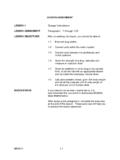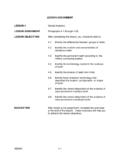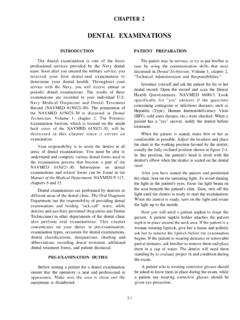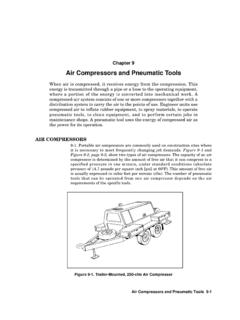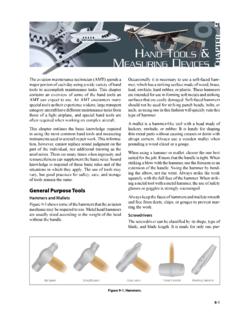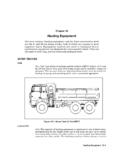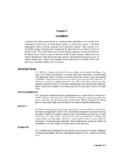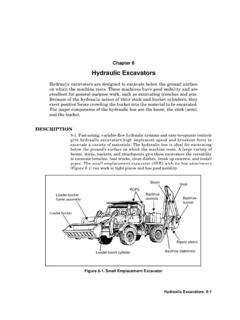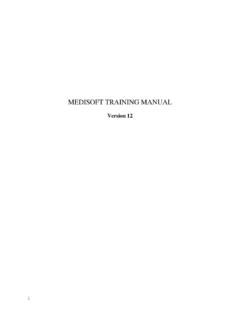Transcription of TEXT ASSIGNMENT LESSON OBJECTIVES - sweethaven02.com
1 LESSON ASSIGNMENT . LESSON 2 Pharmacology TEXT ASSIGNMENT Paragraphs 2-1 through 2-34. LESSON OBJECTIVES After completing this LESSON , you should be able to: 2-1. Compute medication dosages by the ratio and proportion method. 2-2. Convert from one unit to another, using the metric system, apothecary system, and houshold measurements. 2-3. Compute medication dosages for tablets, pills, and capsules. 2-4. Compute oral medication dosages for prepared strength liquids. 2-5. Compute dosages for parenteral medications. 2-6. Compute dosages for medications manufactured in standardized units. 2-7. Compute medication dosages based on body weight. 2-8. Compute continuous intravenous infusion rates. 2-9. Compute intravenous infusion rates for medication. 2-10. Given a medication label, identify the following information: generic name, trade name, strength of the medication, special storage considerations, and expiration date.
2 2-11. Given a physician's order for medication administration and the concentration of a drug solution, suspension, or dosage form, calculate the volume of the solution, suspension, tablet, or capsule to be given. SUGGESTION After completing the ASSIGNMENT , complete the exercises at the end of this LESSON . MD0904 2-1. LESSON 2. PHARMACOLOGY. Section I. ratio and proportion OPERATIONS. 2-1. DEFINITIONS. a. Ratio. (1) The relationship of two quantities. (2) May be expressed as a: (a) Ratio 1:8, 1:200. (b) Fraction 1 _1. 8, 200. b. Proportion: The equality of two ratios 1=3. 2 6. 2-2. CROSS MULTIPLYING. A check as to the equality of two ratios can be made by cross multiplying. a. Multiply the numerator of the first ratio times the denominator of the second ratio. b. Then, multiply the denominator of the first ratio times the numerator of the second ratio.
3 C. If the ratios are the same or equal, the results of the cross multiplication will be the same. EXAMPLE: 1=3. 2 6. 1 3. 2 6. MD0904 2-2. (1) 1x6=6. (2) 2x3=6. (3) 6=6 Therefore, the ratios are equal. 2-3. "X" AS THE UNKNOWN FACTOR. Because the products of the cross multiplications are always equal in a proportion, if one factor of either ratio is unknown, it may be solved by substituting "X". for the unknown factor in the proportion. EXAMPLE: 1=X. 2 6. 1 X. 2 6. Cross multiply: 2 (X) = 1 (6). 2X = 6. 2X = 6. 2 2. X=3. 2-4. RULES FOR ratio and proportion OPERATIONS. a. The numerators must have the same units. b. The denominators must have the same units. c. Three of the four variables must be known. 2-5. SETTING UP THE PROPORTION. The expression of strength of a medication is usually the first ratio of the proportion, and this ratio is put in proportion to the amount of medication to be administered.
4 MD0904 2-3. a. Example--If one aspirin tablet contains five grains of aspirin, then how many tablets will you give in order for the patient to receive 15 grains of aspirin? NOTE: The EXPRESSION OF STRENGTH is "one tablet contains five grains of aspirin" and should be written as the first ratio of the proportion. IF THEN. 1 tablet = _____. 5 grains b. Next, assign "X" its proper place in the second proportion. Because the question asks "How many tablets?" the "X" is placed opposite the tablets in the first ratio. IF THEN. 1 tablet = X tablets 5 grains c. The question asks you to calculate the number of tablets required in order to give 15 grains of aspirin; therefore, the 15 grains will be placed opposite the grains in the first ratio. IF THEN. 1 tablet = X tablets 5 grains 15 grains NOTE: Prior to cross-multiplying, be sure that corresponding units in each ratio are the same.
5 2-6. SOLVING for "X". a. You have set up the proportion: IF THEN. 1 tablet = X tablets 5 grains 15 grains b. Now, cross multiply: 5(X) = 1(15). MD0904 2-4. c. Solve for X: 5X = 15. 5 5. X=3. d. Refer back to step a. to find the units of X. The units for X in this problem is tablets; therefore, the answer is 3 tablets. NOTE: The most common mistake is the failure to label units. Labeling units will ensure that corresponding units of the proportion are the same. 2-7. ROUNDING OFF. a. When rounding answers to the nearest tenth, you must take your calculation out to the hundredth place and then round to the tenth place. EXAMPLE: = b. When rounding answers to the hundredth place, you must take your calculation out to the thousandth place and then round to the hundredth place. EXAMPLE: = c. DO NOT ROUND UNTIL THE LAST STEP OF YOUR CALCULATION!
6 !!! 2-8. PRACTICE 2-1 ( ratio and proportion ). Round answers to the nearest tenth. On Hand Doctor's Order Answer a. Mellaril 100 mg/tab 50 mg. _____. b. Gantrisin Gm/cc 2 Gm _____. c. Demerol 50 mg/cc 25 mg _____. d. Dilantin 100 mg/cc 250 mg _____. e. Valium mg/tab 15 mg _____. f. Ampicillin Gm/tsp 1 Gm _____. g. Lincocin 500 cc 250 mg _____. MD0904 2-5. h. Aldomet Gm/cc Gm _____. i. Atropine gr 1/200/cc gr 1/300 _____. j. Digoxin cc mg _____. k. Vistaril 100 mg/2 cc 75 mg _____. l. Morphine 8 mg/cc 10 mg _____. m. Polycillin 250 mg/ml 500 mg _____. n. Digoxin mg/tablet mg _____. o. Omnipen 125 ml 350 mg _____. p. Kantrex 1 gm/3 ml gm _____. q. Lanoxin Elixir mg/ml mg _____. r. Lasix 20 mg/ml 70 mg _____. s. Dilaudid 2 mg/tablet 3 mg _____. t. Robitussin 10 mg/30 ml 30 mg _____. u. Ativan mg/tablet 2 mg _____. v. Luminal 30 mg/tablet 90 mg _____.
7 W. Gantrisin gm/tablet 1 gm _____. x. Cedilanid mg/2 cc mg _____. y. Scopolomine mg/2 ml mg _____. z. Methicillin 500 mg/cc 750 mg _____. 2-9. ANSWERS TO PRACTICE 2-1. a. 1 tab = X tabs 100 mg 50 mg 100 X = 50. = 1 tab 2. MD0904 2-6. b. 1 cc = X cc Gm 2 Gm X = 2. X = 4 cc c. 1 cc = X cc 50 mg 25 mg 50 X = 25. X = .5 cc d. 1 cc = X cc 100 mg 250 mg 100 X = 250. X = cc e. 1 tab = X tabs mg 15 mg X = 15. X = 6 tabs f. 1 tsp = X tsp Gm 1 Gm = 1. X = 2 tsp g. cc = X cc 500 mg 250 mg 500X = 125. X = = cc MD0904 2-7. h. 1 cc X cc =. Gm Gm = X = cc i. 1 cc = X cc gr 1/200 gr 1/300. 1 X = 1. 200 300. X = 1 : 1. 300 200. X = = cc j. cc = X cc mg mg = .150. X = cc k. 2 cc = X cc 100 mg 75 mg 100X = 150. X = cc l. 1 cc = X cc 8 mg 10 mg 8X = 10. X = cc m. 1 ml = X ml 250 mg 500 mg 250X = 500. X = 2 ml MD0904 2-8. n. 1 tablet = X tablets mg mg = X = 2 tablets o.
8 Ml = X ml 125 mg 350 mg 125X = 175. X = ml p. 3 ml = X ml 1 gm gm X = ml q. 1 ml = X ml mg mg = X = 5 ml r. 1 ml = X ml 20 mg 70 mg 20X = 70. X = ml s. 1 tablet = X tablets 2 mg 3 mg 2X = 3. X = 1 1 tablets 2. t. 30 ml = X ml 10 mg 30 mg 10X = 900. X = 90 ml MD0904 2-9. u. 1 tablet = X tablets mg 2 mg = 2. X = 4 tablets v. 1 tablet = X tablets 30 mg 90 mg 30X = 90. X = 3 tablets w. 1 tablet = X tablets gm 1 gm = 1. X = 4 tablets x. 2 cc = X cc mg mg = X = 4 cc y. 2 ml = X ml mg mg = X = 1 ml z. 1 cc X cc =. 500 mg 750 mg 500 X = 750. X = cc MD0904 2-10. Section II. SYSTEMS OF MEASUREMENT. 2-10. NOTES. a. The Metric System. (1) Units used in the metric system: (a) Liter for volume (fluids). (b) Gram for weight (solids). (c) Meter for measure (length). (2) Metric equivalents used in medicine: (a) Volume--1000 milliliters (ml) = 1 liter (L).
9 (b) Weight: 1 1000 micrograms (mcg) = 1 milligram (mg). 2 1000 mg = 1 gram (gm). 3 1000 gm = 1 kilogram (kg). (3) Procedure for conversion from one unit of the metric system to another: (a) To change milligrams to grams (mg to gm), milliliters to liters (ml to L), or to change grams to kilograms, set up a ratio and proportion based on the equivalent. EXAMPLE 1. Express 50 mg as grams. 50 mg = X gm 1000 mg = 50 mg 1 gm X gm 1000X = 50. X = .05 gm MD0904 2-11. EXAMPLE 2. Express 2200 ml as liters. 2200 ml = X L. 1000 ml 2200 ml =. 1L XL. 1000X = 2200. X = L. (b) To change liters to milliliters, kilograms to grams, grams to milligrams, set up a ratio and proportion based on the equivalent. EXAMPLE 1. Express liters as ml. L = X ml 1L = L. 1000 ml X ml X = 3500 ml EXAMPLE 2. Express gm as mg. gm = X mg 1 gm = gm 1000 mg X mg X = 500 mg b.
10 The Apothecaries' System. (1) The apothecary system is the original system of medication measurement used by pharmacists and physicians. The system is still in use today to a limited extent. In general, drugs that continue to be ordered and dispensed in apothecary units are those that have been in use for many years. For most other drugs the metric system is the system of measurement commonly used. (2) Apothecary equivalents to the metric system. (a) Volume: 1 ounce (oz) = 30 ml 8 oz = 240 ml (approximate). 1 quart (qt) = 1000 ml (approximate) (4 cups). MD0904 2-12. (b) Weight: 1 grain (gr) = 60 mg 1 oz = 30 gm lbs = 1 kg 1000 gm = 1 kg (3) It is important to understand that the apothecary system is only approximately equivalent to the metric system and to the common household system. (4) In the apothecary system, fractions and Roman numerals are commonly used to designate numbers.
